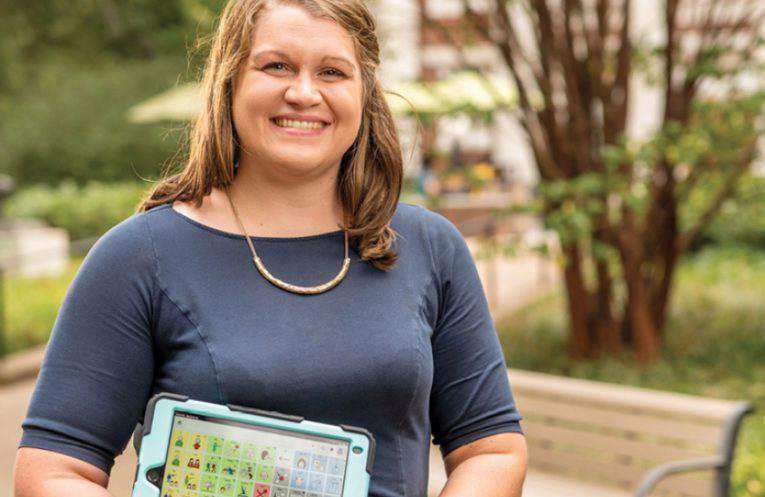A new study published in Language, Speech, and Hearing Services in Schools explores how elementary school-aged peers can be taught to support classmates with autism who are minimally speaking. The research was conducted by Vanderbilt Kennedy Center (VKC)(TN IDDRC, UCEDD, LEND) member Elizabeth Biggs, PhD, and demonstrates that peers can learn and apply responsive interaction strategies — called the “Ways to Talk and Play” — to foster play and communication using augmentative and alternative communication (AAC).
Approximately 30 to 40 percent of autistic students are minimally speaking, meaning they use fewer than 30 functional spoken words. These students often face barriers to peer interaction, which can lead to social isolation. While AAC tools like speech-generating devices (SGDs) can support communication, their effectiveness depends on how well natural communication partners — especially peers — are equipped to use them.
This study aimed to determine whether peers could learn to use three responsive interaction strategies within a peer network intervention:
- Play–Talk–Give: Model a play action, talk about it (with speech and AAC), and offer the toy to a peer.
- Copy–Talk: Imitate a peer’s play and comment on it (using speech and AAC).
- Respond: Notice and respond to any communication attempt (using speech and AAC).
The study involved two 9-year-old, minimally speaking autistic students, Hector and Mateo, each paired with two peers from their general education classrooms. All participants attended a public elementary school in a large urban district. The intervention was facilitated by trained graduate students and supported by the students’ educational teams, including special educators, speech-language pathologists (SLPs), and paraprofessionals.
Peers received a 20-minute introductory teaching session using visuals and video models and ongoing coaching during play-based peer network sessions held 3–4 times per week over four weeks.
AAC access was provided via iPads with customized vocabulary sets. Play materials were selected based on student and peer preferences to encourage engagement.
Biggs and her team found that not only did the peers effectively learn the strategies, but the nature of group interactions also changed in beneficial ways.
“All four peers demonstrated increased use of the responsive interaction strategies during intervention phases, and interactions became more balanced and reciprocal,” said Biggs. “For example, Hector’s peers shifted from one-sided interactions to more mutual exchanges. Regarding AAC devices, use remained limited, but both students and peers reported positive experiences with the devices. And finally, the students, peers, and educators all rated the intervention positively. Peers reported feeling more confident and capable of interacting with their classmates.”
“It’s [the intervention] very important because it helps them [students with disabilities] learn,” said one of the peer participants. “And it teaches kids without disabilities how to play in different ways and how to play with people who play different than them. I think other kids would like this because they would be able to become friends with people with disabilities. It would be good if kids without disabilities played more with kids with disabilities.”
The study highlights the importance of equipping peers — not just educators — with tools to support communication. The “Ways to Talk and Play” strategies are practical, easy to teach, and promote equal-status relationships rather than helper roles. Educators and SLPs can integrate these strategies into peer network interventions to foster meaningful social connections.
However, the study also suggests that peers may need more time and support to fully integrate AAC into their interactions. School leaders can support implementation by providing collaborative planning time and flexible service delivery models that include inclusive group sessions.
Biggs and her team are currently conducting a larger randomized control trial to evaluate the effectiveness of these strategies within a larger intervention model, called the Enhancing Peer Networks Project.
Photo of Elizabeth Biggs by John Russell/Vanderbilt
Biggs, E.E., Turner, E.C., Elchos, E., Spann, E., & Scotti, K. (2025). Teaching Elementary-Aged Responsive Interaction and Augmentative and Alternative Communication Strategies Within a Peer Network Intervention. Language, Speech, and Hearing Services in Schools, 56, 380–396. https://doi.org/10.1044/2025_LSHSS-24-00092











